The Nikon D5200 is a versatile DSLR camera designed for enthusiasts and professionals, featuring a 24.1MP DX-format CMOS sensor and EXPEED 3 image processor. It offers excellent image quality, Full HD video recording, and a wide range of shooting modes. Priced at Rs 46,950 with an 18-55mm VR kit lens, it’s an ideal choice for those seeking advanced photography capabilities. The comprehensive manual provides detailed guidance to unlock its full potential.
Overview of the Camera
The Nikon D5200 is a high-performance DSLR camera designed for photography enthusiasts and professionals. It features a 24.1-megapixel DX-format CMOS sensor and the powerful EXPEED 3 image processor, ensuring exceptional image quality and color accuracy. The camera offers a vari-angle 3-inch LCD screen for flexible shooting angles and a robust set of manual controls for creative freedom. With its lightweight and ergonomic design, the D5200 is ideal for both still photography and Full HD video recording. It supports a wide range of Nikon lenses and accessories, making it a versatile tool for capturing diverse subjects and scenes. The D5200 is well-suited for photographers seeking advanced features without compromising on portability and ease of use.
Key Features and Benefits
The Nikon D5200 boasts a range of advanced features that cater to both enthusiasts and professionals. Its 24.1-megapixel DX-format CMOS sensor delivers high-resolution images with vibrant colors and sharp details. The EXPEED 3 image processor enhances performance, ensuring fast operation and excellent noise reduction. The camera also features a vari-angle 3-inch LCD screen, providing flexibility for shooting at unique angles. With Full HD video recording at 60i/50i, it’s ideal for capturing smooth and cinematic footage. The 39-point autofocus system ensures precise subject tracking, while the Scene Recognition System improves exposure and autofocus accuracy. Wireless connectivity via the optional WU-1b module allows for easy image transfer and remote shooting. These features make the D5200 a powerful yet user-friendly tool for capturing stunning stills and videos.
Target Audience
The Nikon D5200 is designed for photography enthusiasts seeking a balance between performance and affordability. It appeals to beginners transitioning from compact cameras and intermediate photographers looking to refine their skills. Hobbyists interested in creative control and high-quality images will find it ideal. The camera is also suitable for professionals needing a lightweight backup or teaching tool. Its intuitive interface and advanced features make it accessible for various skill levels. Whether for travel, portraits, or nature photography, the D5200 caters to those who value image quality and versatility without the bulk of higher-end models. Its portability and robust feature set make it a versatile choice for diverse photographic needs and preferences.
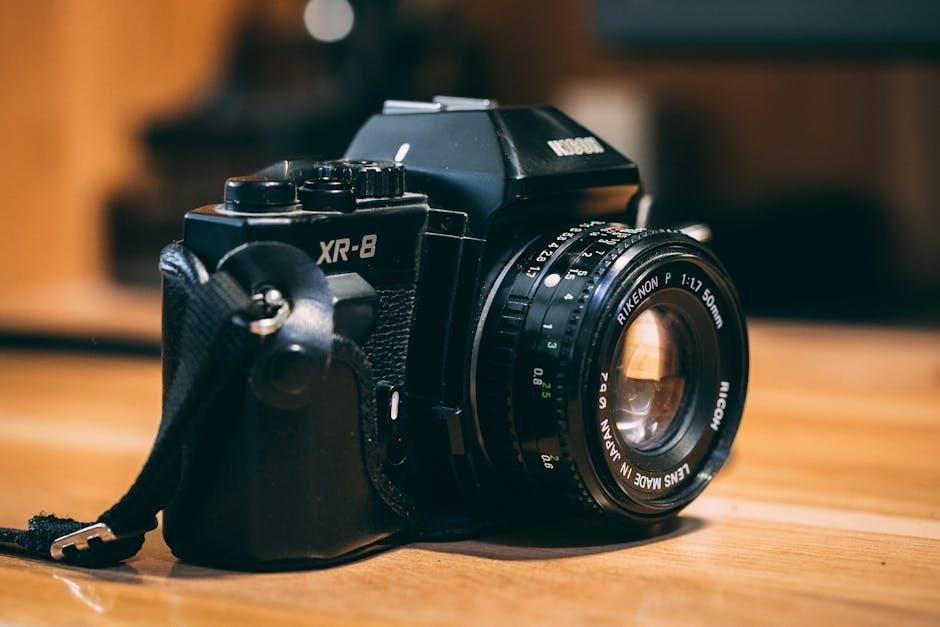
Camera Specifications
The Nikon D5200 features a 24.1MP APS-C sensor, EXPEED 3 processor, 100-6400 ISO range, and a 3-inch vari-angle LCD, offering a blend of performance and versatility for photographers.
Image Sensor and Processor
The Nikon D5200 is equipped with a 24.1-megapixel APS-C CMOS image sensor, delivering high-resolution images with impressive detail and vibrant colors. Combined with the powerful EXPEED 3 image processor, the camera ensures efficient processing of data, resulting in faster operation and improved noise reduction. This pairing enables the D5200 to capture sharp images even in challenging lighting conditions. The sensor’s design allows for a wide dynamic range, preserving both highlights and shadows, while the processor enhances color accuracy and overall image quality. Together, they provide a solid foundation for photographers seeking to produce professional-grade results.
ISO Range and Noise Performance
The Nikon D5200 offers a versatile ISO range of 100 to 6400, which can be expanded to ISO 25600 in Hi mode, making it suitable for a variety of lighting conditions. The camera’s EXPEED 3 processor works to minimize noise, ensuring cleaner images even at higher sensitivity settings. While noise becomes more noticeable at ISOs above 1600, the D5200 handles it well compared to its peers. This balance of sensitivity and noise control makes it an excellent choice for photographers capturing low-light scenes without compromising image quality. The ability to adjust ISO settings manually or automatically provides flexibility, catering to both novice and advanced users aiming for optimal results in diverse environments.
Autofocus System
The Nikon D5200 features an advanced 11-point autofocus system, designed to deliver fast and precise focus acquisition. Utilizing the Multi-CAM 4800DX autofocus sensor, the camera excels in various lighting conditions, including low light. The central cross-type sensor enhances accuracy with lenses of f/5.6 or faster, while the other sensors provide reliable performance. Users can choose from three AF modes: Single-Servo AF for stationary subjects, Continuous-Servo AF for moving subjects, and Manual Focus for precise control. The AF assist light aids in focusing during low-light conditions, and the camera supports face-priority AF in live view mode. This versatile system ensures sharp images, catering to both still photography and dynamic situations.
Video Recording Capabilities
The Nikon D5200 supports Full HD video recording at 1080p resolution, capturing smooth footage at 60i or 50i frame rates. It also offers 720p at 60p for slower-motion effects. Videos are encoded in the MPEG-4 AVC/H.264 format, ensuring high-quality and efficient file compression. The camera allows manual control of exposure settings during recording, enabling precise adjustments for professional results. Additionally, the D5200 features a built-in stereo microphone for capturing clear audio and includes a 3.5mm external microphone jack for enhanced sound quality. Time-lapse and interval shooting modes are also available for creative video applications. Maximum recording time per clip is 29 minutes and 59 seconds, with file sizes limited to 4GB. These features make the D5200 a versatile tool for both casual and advanced videographers.
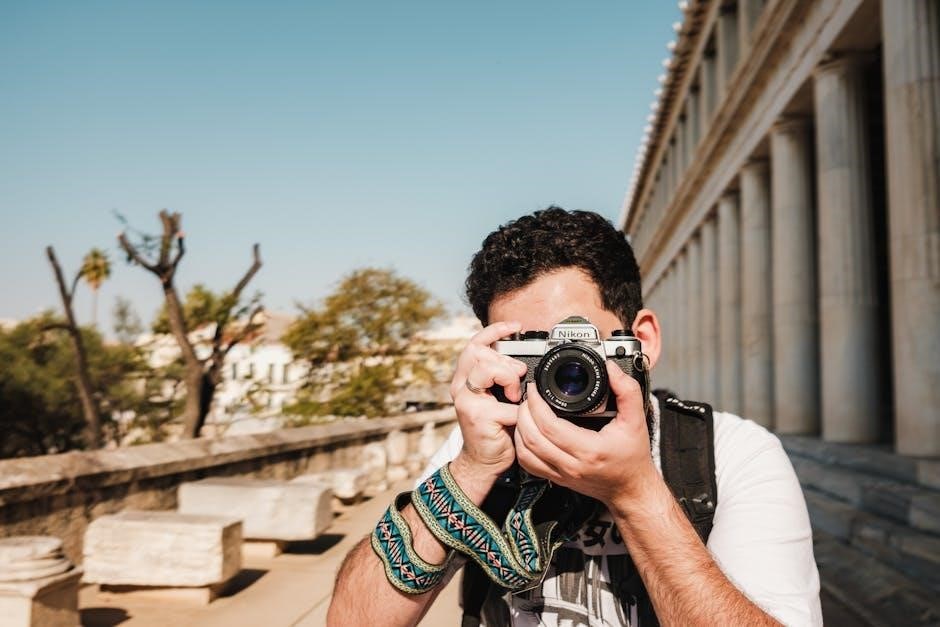
Shooting Modes
The Nikon D5200 offers various shooting modes, including Auto, Program Auto, Scene, Manual, Aperture Priority, and Shutter Priority, catering to both beginners and advanced photographers.
Auto Mode
In Auto Mode, the Nikon D5200 simplifies photography by automatically adjusting settings like aperture, shutter speed, and ISO for optimal results. Designed for beginners or casual shooters, this mode eliminates the need for manual adjustments, ensuring sharp and well-exposed images in most lighting conditions. The camera also selects the appropriate autofocus mode and activates features like face detection and automatic scene selection. While it limits creative control, Auto Mode is ideal for quick, point-and-shoot situations. Users can still adjust basic settings like image quality and flash usage through the menu. This mode is perfect for capturing family moments, travel photos, or everyday scenes without worrying about technical details, making it a great starting point for new photographers.
Program Auto Mode
Program Auto Mode (P) on the Nikon D5200 offers a balance between simplicity and control, making it ideal for photographers who want to step beyond fully automatic shooting. In this mode, the camera automatically sets both aperture and shutter speed to ensure a properly exposed image. However, users can adjust settings like ISO, white balance, and autofocus to fine-tune results. This mode is particularly useful for capturing portraits, landscapes, and dynamic lighting conditions while maintaining creative flexibility. The camera prioritizes optimal exposure but allows for adjustments through the menu system. Program Auto Mode is a great intermediate step for photographers transitioning from Auto Mode to more manual controls, offering convenience without sacrificing the ability to make key adjustments for better image quality.
Scene Modes
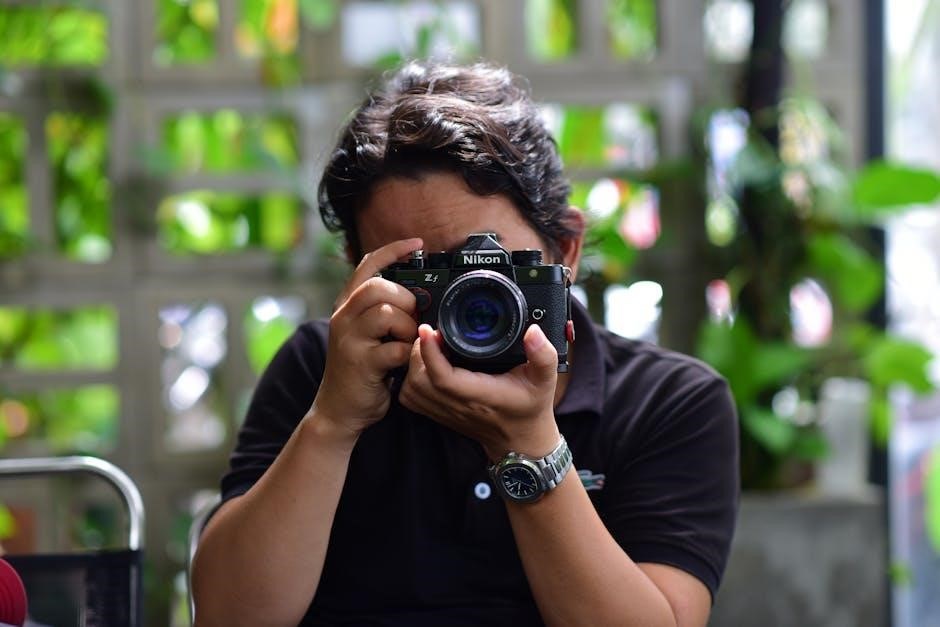
The Nikon D5200 offers a variety of Scene Modes designed to optimize camera settings for specific shooting scenarios. These modes include Portrait, Landscape, Child, Sports, Close-up, and Night Portrait. Each mode automatically adjusts settings like aperture, shutter speed, and ISO to capture the best possible image for the selected scene. For example, Portrait mode emphasizes a shallow depth of field to blur backgrounds, while Landscape mode prioritizes sharpness and detail across the entire frame; These modes are ideal for photographers who want to achieve professional-looking results without manually adjusting settings. Scene Modes provide a middle ground between Auto Mode and manual controls, offering customization options like white balance and autofocus while handling complex exposure calculations; They are a versatile tool for capturing a wide range of subjects and conditions with ease and precision.
Manual and Priority Modes
The Nikon D5200 offers Manual (M) and Priority Modes—Shutter Priority (Tv) and Aperture Priority (Av)—for advanced photographers seeking greater control over exposure settings. In Manual Mode, users can independently adjust aperture, shutter speed, and ISO for complete creative freedom. Shutter Priority Mode allows photographers to set the shutter speed, with the camera automatically adjusting the aperture to maintain proper exposure. Aperture Priority Mode works conversely, letting users set the aperture while the camera adjusts the shutter speed. These modes are ideal for photographers who understand exposure fundamentals and want to tailor their settings to specific artistic or technical goals. They provide a balance between automation and manual control, enabling precise adjustments while streamlining the shooting process.
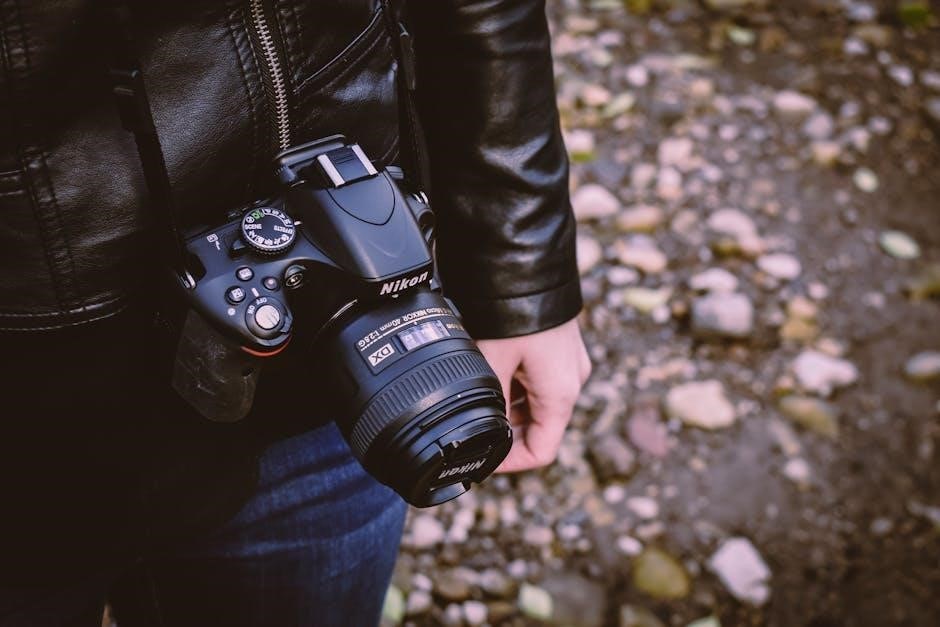
Customization Options
The Nikon D5200 offers extensive customization options, allowing users to tailor settings to their preferences. Assign functions to buttons, personalize the menu, and streamline workflows for enhanced creativity.
Custom Setting Menu
The Nikon D5200’s Custom Setting Menu provides users with detailed control over camera functions, allowing for precise adjustments to suit individual preferences. It includes options for autofocus modes, metering patterns, exposure settings, and more. Users can customize noise reduction levels, Active D-Lighting, and bracketing options. The menu also allows for fine-tuning ISO sensitivity, autofocus tracking, and flash exposure. These settings enable photographers to optimize the camera’s performance for specific shooting conditions or personal style. By exploring the Custom Setting Menu, users can streamline their workflow and enhance creativity, ensuring consistent results across various photography scenarios.
Button Assignments
The Nikon D5200 allows users to customize button assignments, enhancing workflow efficiency. The AE-L/AF-L button can be configured to suit individual preferences, such as toggling between AF modes or locking exposure. Additionally, the Fn button and preview button can be reassigned to access frequently used settings like ISO, white balance, or bracketing. This customization enables quicker access to critical functions, reducing time spent navigating menus. By tailoring button assignments, photographers can streamline their shooting process and focus on capturing moments seamlessly. The camera’s flexibility in button customization is particularly beneficial for those who prefer a personalized approach to their photography workflow.
Menu Navigation
The Nikon D5200 features an intuitive menu system designed for easy navigation. The camera’s menu is divided into tabs, including Shooting, Setup, Retouch, and My Menu, each containing relevant settings. Users can navigate using the multi-selector on the rear of the camera, with options highlighted as they scroll. The Shooting Menu provides access to settings like AF mode, metering, and image quality, while the Setup Menu handles camera maintenance and customizations. The Retouch Menu offers in-camera editing options, and My Menu allows users to save up to 20 frequently used settings for quick access. The menu system is user-friendly, making it easy for both beginners and advanced photographers to find and adjust settings efficiently. This streamlined design enhances the overall shooting experience.
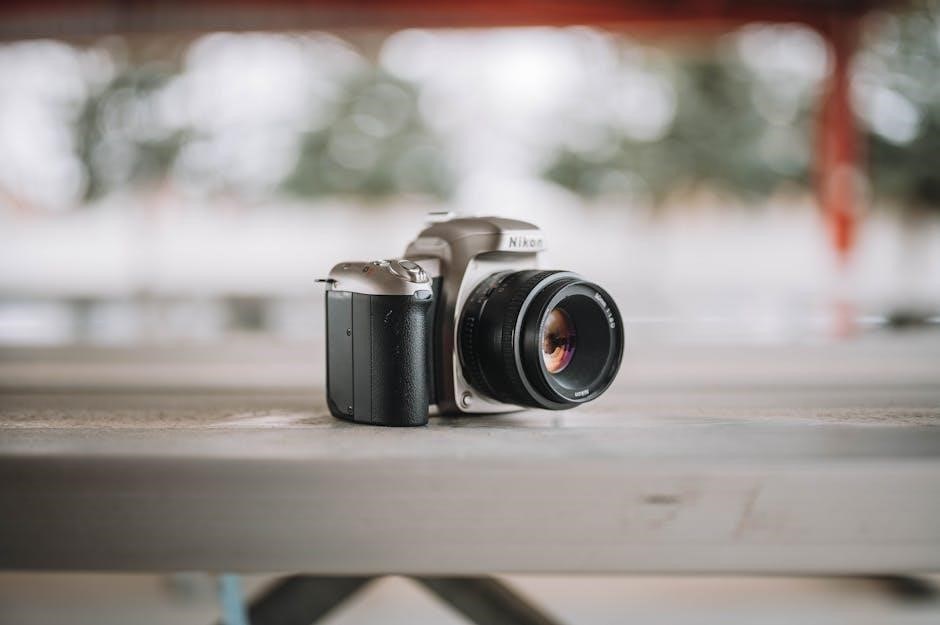
Technical Details
The Nikon D5200 features a lightweight polycarbonate body, weighing approximately 555g with dimensions of 129x98x78mm. Its durable build ensures reliability for various shooting conditions.
Lens Compatibility
The Nikon D5200 is compatible with Nikon’s F-mount lenses, offering a wide range of options for photographers. It supports AF-S, AF-D, and older manual-focus lenses, ensuring versatility. The camera is designed for DX-format lenses, which are optimized for its APS-C sensor, but it can also use FX-format lenses with a 1.5x crop factor. Additionally, non-CPU AI and AI-S lenses can be used in manual mode, though with limited metering functionality. This compatibility allows photographers to explore various focal lengths and specialized lenses, such as wide-angle, telephoto, and macro, to suit their creative needs. The lens ecosystem provides ample opportunities for experimentation and growth, catering to both beginners and advanced shooters.
Viewfinder and LCD
The Nikon D5200 features a pentamirror single-lens reflex viewfinder with approximately 95% frame coverage, ensuring a clear and accurate preview of your shots. The 3-inch vari-angle LCD screen offers 921,000 dots of resolution, providing sharp and vibrant image playback. The vari-angle design allows for flexible shooting from high, low, or unusual angles, making it ideal for creative compositions. The LCD also supports live view, enabling precise focus and framing in both stills and video modes. The combination of a reliable viewfinder and a versatile LCD enhances the camera’s usability, catering to both casual and advanced photographers. This dual display system ensures you can capture and review your images with precision and ease.
Burst Mode and Buffer
The Nikon D5200 supports continuous shooting in burst mode, capturing up to 3 frames per second in its Continuous Shooting mode. This feature is ideal for action photography or capturing fleeting moments. The camera’s buffer allows for a maximum of 7 consecutive RAW files or up to 15 JPEGs before it needs to pause and write data to the memory card. The buffer capacity depends on the shutter speed and file format, with slower shutter speeds reducing the number of frames that can be captured in a burst. For optimal performance, using a high-speed memory card is recommended to minimize buffering delays.
While the burst mode is not as fast as higher-end DSLRs, it is sufficient for casual and amateur photographers. The buffer clears relatively quickly, allowing you to resume shooting without significant downtime. This makes the D5200 a practical choice for capturing dynamic scenes, even with its moderate burst capabilities.
Storage and File Formats
The Nikon D5200 supports various storage options, including SD, SDHC, and SDXC memory cards, with compatibility for UHS-I standards for faster data transfer. The camera can store images in multiple file formats, including RAW (NEF), JPEG, and RAW+JPEG. RAW files capture uncompressed image data for maximum post-processing flexibility, while JPEG files are smaller and ready for sharing. The D5200 also supports the Adobe RGB color space for wider color accuracy. For video recording, the camera uses MOV format with H.264/MPEG-4 compression. Proper memory card selection is essential to ensure smooth performance, especially when shooting in burst mode or recording video. Using a high-speed card is recommended to optimize the camera’s capabilities.
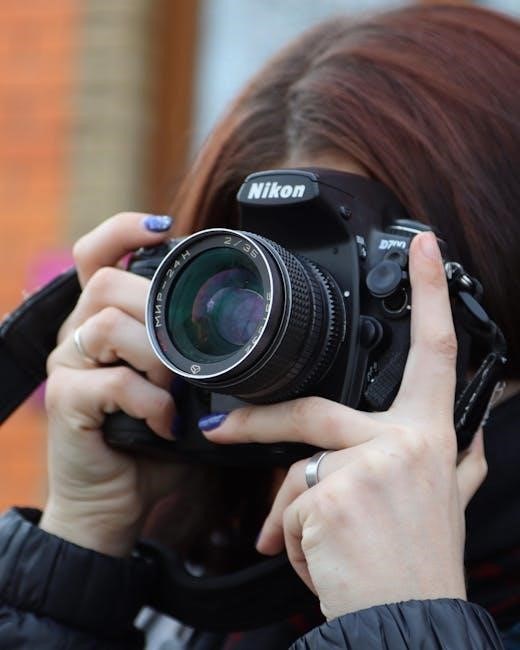
Accessories
The Nikon D5200 supports a wide range of accessories, including lenses, flashes, tripods, and remote shutters, enhancing functionality and personalization for diverse photography needs.
Lenses
The Nikon D5200 is compatible with a wide range of Nikon F-mount lenses, offering versatility for various photography styles. The camera supports both DX and FX format lenses, though DX lenses are optimized for the APS-C sensor. Popular choices include the AF-S DX NIKKOR 18-55mm f/3.5-5.6G VR kit lens for everyday shooting and the AF-S DX NIKKOR 35mm f/1.8G for portraits. Telephoto zooms like the AF-S DX NIKKOR 55-300mm f/4.5-5.6G ED VR are ideal for wildlife and sports. Prime lenses provide excellent sharpness, while wide-angle and fisheye lenses add creative perspectives. Nikon’s lens technology, including ED glass and VR stabilization, enhances image quality. Users can also explore older AF and AI lenses, though some features may not work. The camera’s compatibility with a broad lens lineup makes it adaptable to diverse photographic needs.
Flash and External Lighting
The Nikon D5200 features a built-in pop-up flash with a guide number of 12 (ISO 100, meters) and coverage for a 24mm lens, making it ideal for fill lighting or snapshots. For more advanced lighting, the camera supports external Speedlights like the SB-300, SB-500, and higher-end models. These flashes offer bounce, swivel, and wireless capabilities, enhancing creativity and control. The D5200 can also act as a commander in Nikon’s Creative Lighting System (CLS), enabling wireless control of external flashes. This setup is perfect for studio or multi-flash photography. External lighting options provide superior illumination and flexibility, catering to professionals and enthusiasts seeking precise lighting effects. The camera’s compatibility with Nikon’s flash system ensures a wide range of lighting solutions are available to suit different needs and preferences.
Tripod and Remote Shutter Release
A tripod is essential for stabilizing the Nikon D5200, especially in low-light conditions or when using long lenses. The camera features a standard 1/4-inch tripod mount, compatible with most tripods; For precise control, the D5200 supports the ML-L3 wireless remote or the MC-DC2 wired remote shutter release, minimizing camera shake during shooting. These accessories are ideal for long exposures, time-lapse photography, or macro work. Additionally, the camera’s Wi-Fi capability allows for remote shooting using a smartphone with the Nikon WMU app. A tripod ensures sharp images, while remote shutters enhance precision and convenience, making them indispensable tools for photographers seeking professional results. These accessories are particularly useful for landscape, portrait, and studio photography, where stability and control are crucial.
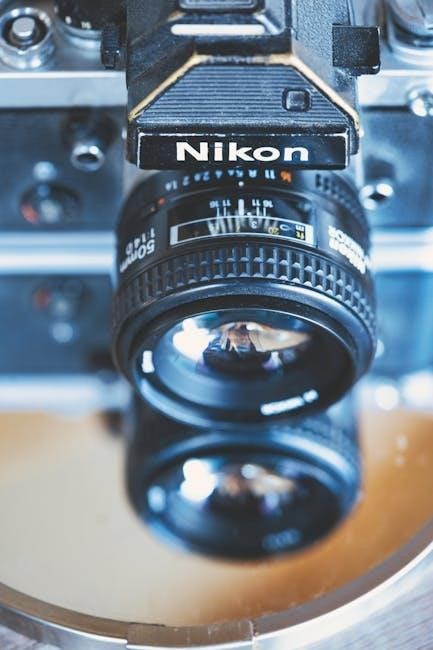
Maintenance and Troubleshooting
- Regularly clean the sensor and lens with a soft cloth and blower to prevent dust and smudges.
- Check for error messages and refer to the manual for solutions; reset settings if issues persist.
Camera Cleaning
Regular cleaning is essential to maintain the Nikon D5200’s performance. Use a soft, dry cloth to wipe the camera body and lens surfaces. For the LCD, gently remove smudges with a microfiber cloth. Avoid using liquids, as they may damage the screen. The viewfinder can be cleaned with a soft-bristle brush or a microfiber cloth. For the image sensor, use a hand blower or a cleaning brush to remove dust. If necessary, activate the Clean Image Sensor function via the setup menu. Always clean in a dust-free environment and avoid touching internal components. Cleaning should be done carefully to prevent scratches or damage to sensitive parts. Refer to the manual for detailed steps and precautions to ensure proper maintenance.
Common Error Messages
The Nikon D5200 may display error messages that indicate specific issues. One common error is ERR, which often relates to lens or settings problems. This can occur if the lens is not properly attached or if there is a conflict in settings. Another error is CARD, which signals issues with the memory card, such as corruption or incompatibility. The F– error indicates a problem with file numbering, which can be resolved by formatting the memory card. Additionally, the BEEP error may appear if the camera’s audible signals are not functioning. Always refer to the manual for specific solutions, as some errors may require resetting the camera or updating firmware. Proper troubleshooting can help restore normal functionality. Regular maintenance can prevent many of these issues.
Firmware Updates
Firmware updates are essential for optimizing the performance of the Nikon D5200. Nikon periodically releases updates to improve functionality, fix bugs, and enhance compatibility with lenses and accessories. To check for updates, visit Nikon’s official website and download the latest version. The update process typically involves copying the firmware file to a memory card and installing it via the camera’s menu. Always follow the instructions carefully to avoid errors. Updating the firmware can unlock new features, improve autofocus accuracy, and ensure better compatibility with the latest Nikon lenses and accessories. Regularly checking for updates ensures your camera operates at its best. For detailed steps, refer to the camera manual or Nikon’s support page.
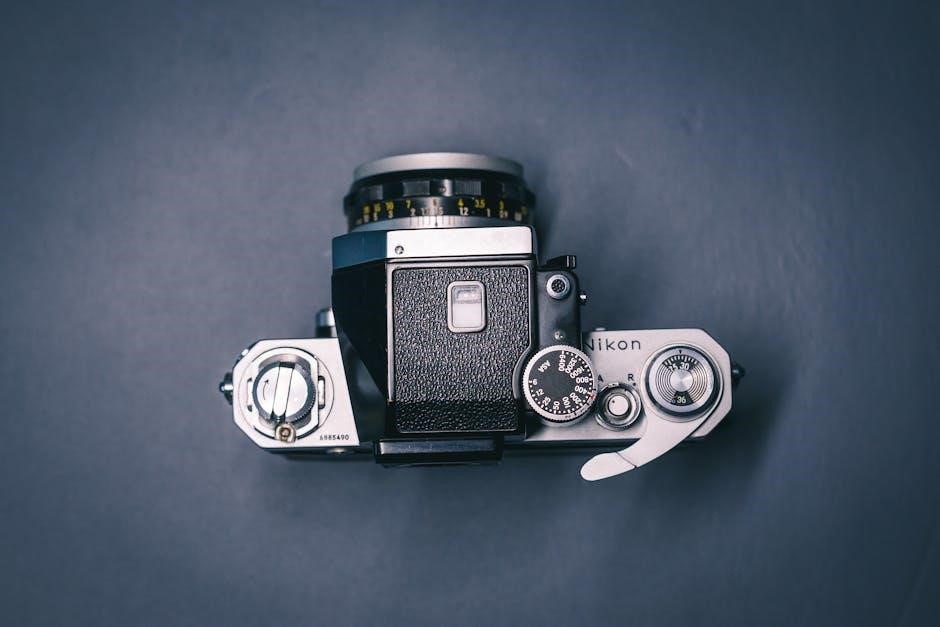
Additional Resources
The Nikon D5200 manual is available for download online. Explore online tutorials for tips and tricks. Join the Nikon community for support and shared knowledge.
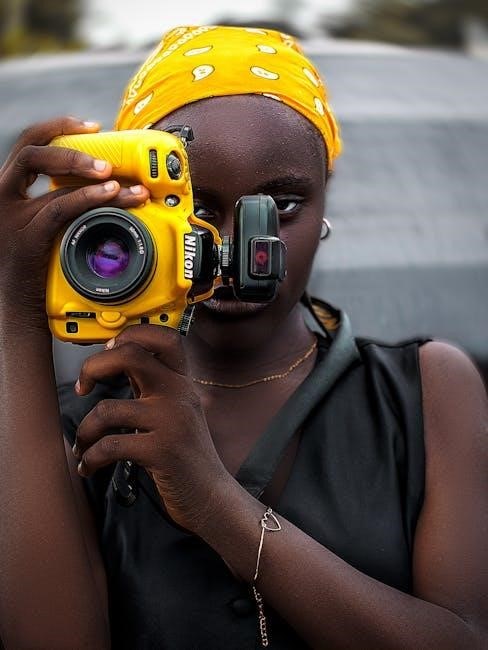
Downloading the Manual
To access the Nikon D5200 camera manual, visit the official Nikon website. Navigate to the “Support” section and search for the D5200 model. Select your preferred language and download the PDF manual. This comprehensive guide covers all camera features, settings, and troubleshooting tips. Ensure you download the correct version for your region. The manual is free and available in multiple languages. Save it for offline use to reference anytime. This resource is essential for mastering the camera’s functions and settings. It also includes detailed instructions for customizing settings and resolving common issues. Regularly check Nikon’s website for updated versions of the manual.
Online Tutorials
Nikon offers a variety of online tutorials to help users master the D5200 camera. These resources are available on Nikon’s official website and cover topics like basic camera operation, advanced settings, and creative techniques. Video tutorials provide step-by-step guidance, making it easier to understand complex features. Additionally, Nikon’s YouTube channel features instructional videos tailored for the D5200. Many photography websites and forums also host user-generated tutorials, offering practical tips and tricks. Online tutorials are an excellent way to improve your skills and explore the full potential of the camera. They are accessible anytime, allowing you to learn at your own pace. These resources are ideal for both beginners and experienced photographers looking to refine their techniques.
Nikon Community
The Nikon Community is a vibrant platform where photographers share knowledge, experiences, and inspiration. It serves as a hub for D5200 users to connect, learn, and grow together. Members can participate in forums, join groups, and attend workshops. The community is rich with resources, including shared tips, tutorials, and feedback on photos. Nikon often hosts events and webinars, fostering engagement among enthusiasts. Whether you’re a beginner or an advanced user, the community provides valuable support and motivation. It’s an excellent way to stay updated on the latest trends and techniques. Active participation in the Nikon Community can enhance your photography skills and help you make the most of your D5200 camera.